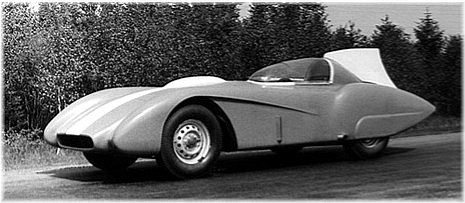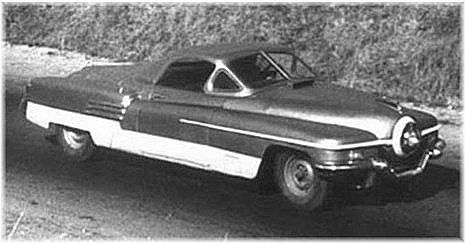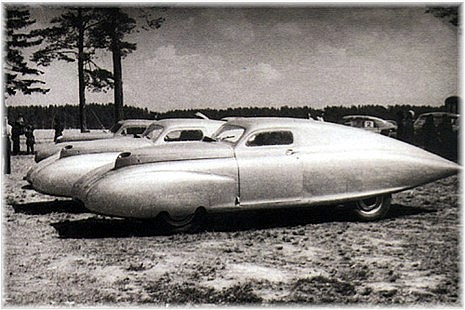Rare Russian Race Cars
By faksta
One of the most successful Soviet racing cars, the ZIL 112 S, appeared in 1962. As with most Soviet sports cars, the 112 S used parts from production Soviet cars. For example, the front suspension was taken from a GAZ 21 Volga, though the rear suspension was fully original, as well as disk brakes on all wheels (rear brakes were settled down to a main gear). Of two cars built, one had a 6-liter V8 engine providing 230hp, and the other, a 6.95-liter V8 capable of 270hp, both developed from the stock ZIS 110 unit. Depending on the engine, the 112 S could run 260-270km/h. As with the engines, transmissions were taken from ZIS 110, but redesigned slightly to employ lightened aluminum components. Compared to earlier 112 modifications, the 112 S had shorter wheelbase (2190mm) and less weight (1300kg).

Driving the 230hp
car, Viktor Galkin came 3rd in 1963 Soviet championship, and in 1965, the 270hp
112 S won the championship with Gennadi Zharkov at the wheel.
In 1962, one of the
cars received a brand-new, more enclosed body and belly-pan fairing, covering
all the mechanicals beneath the car, to attempt a run at a Soviet land speed
record. The 112 RG, as it was named, was taken to the

The second record
attempt was made at the just-built 14-kilometer Dmitrovski autorange. This time,
the ZIL team planned to beat a record of average speed set during the 24h race.
It’s not clear to this author if
the car would have been the 112 S, or in fact the 112 RG, later rebuilt back
into the 112 S configuration), but as the car and the track were prepared, winter weather began, and no record
attempt could be taken. The next year ZIL management considered the building
racing cars an unnecessary capital waste, and switched to another
endeavors.
For a long time,
both 112 S cars were left standing somewhere at the factory, and later found a
home in the
The first two pictures in this article show a standard ZIL 112 S, while the third one features a speed record-prepared 112 RG. Pictures were taken from the article in Autopilot magazine.

The ZIS 112/1, or simply ZIS 112, was developed to compete with
the GAZ SG-1 (Pobeda Sport). As usual for ZIS (later ZIL), the 112 was designed
incorporating styling elements common to American cars. In this case, the
styling of the Buick LeSabre show car was mimicked. The design of the car was
carried out by Valentin Rostkov, who had also worked on the ZIS 101 A
Sport.
The car was built on production chassis taken from ZIS 110 that
was almost 6 meters long, featuring a round grille and a single headlight in the
middle, the 112/1 was called 'Cyclopus' or 'Single-eyed' by the workers. By the
way, the 112 became the first car to carry ZIL's white-and-blue
livery.
At the beginning, the car had 140hp from production ZIS 110 limousine, but for the 2450kg car it was 'a bit' weak, so within a year of it’s construction in 1951, a new experimental engine was installed in the car. Developed by Vasili Rodionov, the inline-eight engine displaced 6005cc and provided 182hp at 3500rpm. The new unit pprowered the car to 204km/h. But, along with more power, the new engine added much more weight to a front axle, so the 112/1 was very hard to handle. Hard to say how the car would have handled curvy tracks, as that time, races were held on straights, but the 112/1 was hard on its brakes and the car was very unstable. The ZIS 112 tried its best at straight-line line races on the Minskoe highway, but soon it became clear that it was not well suited even for such competitions.
In 1954 the wheelbase was decreased by 600mm, along with the body
length, so the weight fell by almost 500kg. The engine was modified, too - power
grew up to 192hp at 3800rpm, and the 112/1 could now reach 210km/h – making it
the fastest Soviet car ever, up to that time. The same year saw the 112/1
without its roof for the first time, as well.

In 1955, the 112/1
participated in Soviet championship again, now held at new circuit in

1950 - K. Nikishin's SG-1 without duralumin aerodynamic body panels in 1950
The GAZ SG-1 has
made its racing debut in 1950, when two cars were entered to race in first USSR
Championship near

Three cars during 1951 USSR Championship.
The following year, when the regulations became much more liberal, Alexey Smolin, an engineer responsible for the SG-1 project, upgraded the cars. Of the three SG-1's prepared for 1951 season, two cars had further modified Pobeda engines, now 2487cc supercharged units with a standard compression rate and one carburetor giving out 105hp at 4000rpm. The third car has been taken to NAMI, where it received a naturally-aspirated prototype engine with an output of 91hp at 4000rpm. The third, 105hp engine prepared by GAZ, was placed under the bonnet of a new racing car, the GAZ SG-2. The SG-1 cars didn't succeed in 1951 USSR Championship round - all of the three cars had retired with mechanical problems.

Naturally aspirated GAZ SG-1 in 1955
In
1952 the regulations were strengthened, and superchargers, as well as aerodynamic bodies and bigger
displacement engines, were
restricted. This drove Smolin to return to the 1950 engines, but this time with
two spark plugs per each cylinder instead of one. This configuration provided
only 80-82hp, and the cars were again unsuccessful. But in 1954, when
aerodynamic bodies were again allowed (they started with a handicap), the SG-1's
were modified again. Increased compression ratios – power now reached 85hp at
4000rpm - less weight, and an aerodynamic shape let V. Mosolov win the
The story is based on Lev Shugurov's article.

